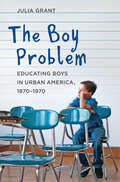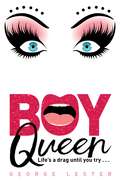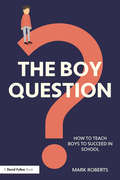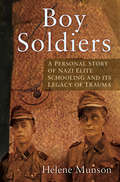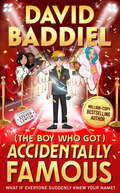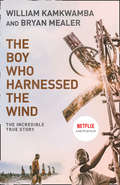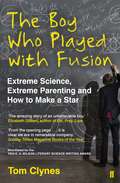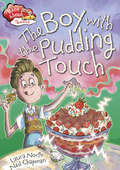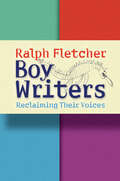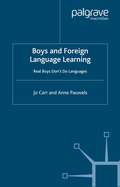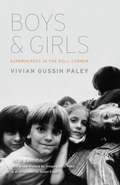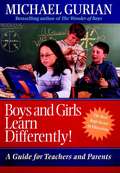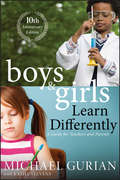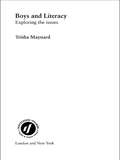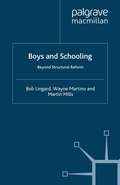- Table View
- List View
The Boy Problem: Educating Boys in Urban America, 1870–1970
by Julia GrantAmerica’s educational system has a problem with boys, and it’s nothing new.The question of what to do with boys—the "boy problem"—has vexed educators and social commentators for more than a century. Contemporary debates about poor academic performance of boys, especially those of color, point to a myriad of reasons: inadequate and punitive schools, broken families, poverty, and cultural conflicts. Julia Grant offers a historical perspective on these debates and reveals that it is a perennial issue in American schooling that says much about gender and education today.Since the birth of compulsory schooling, educators have contended with what exactly to do with boys of immigrant, poor, minority backgrounds. Initially, public schools developed vocational education and organized athletics and technical schools as well as evening and summer continuation schools in response to the concern that the American culture of masculinity devalued academic success in school. Urban educators sought ways to deal with the "bad boys"—almost exclusively poor, immigrant, or migrant—who skipped school, exhibited behavioral problems when they attended, and sometimes landed in special education classes and reformatory institutions. The problems these boys posed led to accommodations in public education and juvenile justice system.This historical study sheds light on contemporary concerns over the academic performance of boys of color who now flounder in school or languish in the juvenile justice system. Grant's cogent analysis will interest education policy-makers and educators, as well as scholars of the history of education, childhood, gender studies, American studies, and urban history.
Boy Queen
by George LesterFall wig first into a world of big hair, high heels and even higher stakes in George Lester's debut novel Boy Queen.Life's a drag until you try . . . Robin Cooper’s life is falling apart. While his friends prepare to head off to University, Robin is looking at a pile of rejection letters from drama schools up and down the country, and facing a future without the people he loves the most. Everything seems like it’s ending, and Robin is scrabbling to find his feet.Unsure about what to do next and whether he has the talent to follow his dreams, he and his best friends go and drown their sorrows at a local drag show, where Robin realizes there might be a different, more sequinned path for him . . .With a mother who won't stop talking, a boyfriend who won't acknowledge him and a best friend who is dying to cover him in glitter make up, there's only one thing for Robin to do: bring it to the runway.
The Boy Question: How To Teach Boys To Succeed In School
by Mark RobertsFollowing on from the huge success of Boys Don’t Try? this essential new book answers nine key questions about how teachers and schools can best tackle boys’ academic underperformance. For decades schools have grappled with the most significant barriers to male academic success: a lack of motivation to succeed, poor attitudes to learning, lower literacy levels and a reluctance to read for pleasure or write at length. In this compelling book, Mark Roberts provides clear answers about how teachers can tackle ‘The Boy Question’. Each chapter answers a frequently asked question about how best to teach boys, outlining the issue and demonstrating what can be done about it. Informed by a wealth of research and the author’s personal experience of successfully teaching boys, this book offers an abundance of practical advice for the busy classroom teacher. It will shine a light on what makes boys tick and how we can design effective curriculums to ensure they can best acquire powerful knowledge. With practical advice and examples to help address anti-social attitudes and stem the cycle of boys’ underachievement, this is essential reading for all teachers and school leaders.
The Boy Question: How To Teach Boys To Succeed In School
by Mark RobertsFollowing on from the huge success of Boys Don’t Try? this essential new book answers nine key questions about how teachers and schools can best tackle boys’ academic underperformance. For decades schools have grappled with the most significant barriers to male academic success: a lack of motivation to succeed, poor attitudes to learning, lower literacy levels and a reluctance to read for pleasure or write at length. In this compelling book, Mark Roberts provides clear answers about how teachers can tackle ‘The Boy Question’. Each chapter answers a frequently asked question about how best to teach boys, outlining the issue and demonstrating what can be done about it. Informed by a wealth of research and the author’s personal experience of successfully teaching boys, this book offers an abundance of practical advice for the busy classroom teacher. It will shine a light on what makes boys tick and how we can design effective curriculums to ensure they can best acquire powerful knowledge. With practical advice and examples to help address anti-social attitudes and stem the cycle of boys’ underachievement, this is essential reading for all teachers and school leaders.
Boy Soldiers: A Personal Story of Nazi Elite Schooling and its Legacy of Trauma
by Helene MunsonAt the end of the Second World War, hundreds of thousands of German children were sent to the front lines in the largest mobilisation of underage combatants by any country before or since. Hans Dunker was just one of these children. Identified as extremely gifted aged 9, he left his home in South America in 1937 in pursuit of a ‘proper’ education in Nazi Germany. Instead, he and his schoolfriends, lacking adequate training, ammunition and rations, were sent to the Eastern Front when the war was already lost in the spring of 1945. Using her father’s diary and other documents, Helene Munson traces Hans’ journey from a student at Feldafing School to a soldier fighting in Zawada, a village in present-day Czech Republic. What is revealed is an education system so inhumane that until recently, post-war Germany worked hard to keep it a secret. This is Hans’ story, but also the story of a whole generation of German children who silently carried the shame of what they suffered into old age. It reveals the true cost and long-lasting impacts of such experiences – not just to them, but also to their families and future generations, a warning to a world where thousands of child soldiers are still sent to fight in armed conflicts.
The Boy Who Built a Wall Around Himself (PDF)
by Ali Redford Kara SimpsonBoy built a wall to keep himself safe. Behind it he felt strong and more protected. Then Someone Kind came along. She bounced a ball, sang and painted on the other side of the wall, and Boy began to wonder if life on the other side might be better after all. Written for children aged 4 to 9, this gentle full-colour picture book uses a simple metaphor to explain how children who have had painful or traumatic experiences can build barriers between themselves and other people. It will help children explore their feelings and encourage communication.
The Boy Who Got Accidentally Famous
by David BaddielFrom million-copy bestselling author David Baddiel comes a laugh-out-loud story for readers of 8 and up that takes you on a roller-coaster ride of fame and friendship…
The Boy Who Harnessed the Wind: Creating Currents Of Electricity And Hope (P. S. Ser.)
by William KamkwambaNOW A MAJOR MOTION PICTURED DIRECTED BY AND STARRING CHIWETEL EJIOFOR – AVAILABLE ON NETFLIX
The Boy Who Longed to Look at the Sun: A Story about Self-Care (Nurturing Emotional Resilience Storybooks)
by Juliette TtofaThe Boy who Longed to Look at the Sun is a therapeutic story about self-care. It tells the story of a boy who loves playing outside and becomes fixated with looking at the sun, even though he has been warned it can hurt his eyes. Eventually the boy realises that his priorities have become skewed and he needs to look after his own well-being. The story teaches children the importance of looking after yourself and understanding what is or is not healthy. This beautifully illustrated storybook will appeal to all children, and can be used by practitioners, educators and parents as a tool to discuss the importance of well-being and self-care with children. This story can be purchased alongside six other storybooks as part of a set (ISBN: 9781138556478), as well as in a set alongside the guidebook Nurturing Emotional Resilience in Vulnerable Children and Young People and six other storybooks (9781138556454). The guidebook outlines ways to use these beautifully told and visually appealing stories to nurture emotional resilience with children and will be invaluable tools for anyone working to build emotional resilience with children and young people.
The Boy Who Played with Fusion: Extreme Science, Extreme Parenting and How to Make a Star
by Tom ClynesBy the age of 11, Taylor Wilson had mastered the science of rocket propulsion. At 13, his grandmother's cancer diagnosis drove him to investigate medical uses for radioactive isotopes. And at 14, Wilson became the youngest person in history to achieve nuclear fusion. How could someone so young achieve so much, and what can Wilson's story teach parents and teachers about how to support high-achieving children?In The Boy Who Played with Fusion, science journalist Tom Clynes follows Taylor Wilson's extraordinary journey - from his Arkansas home where his parents encouraged his intellectual passions, to the present, when now-17-year-old Wilson is winning international science competitions with devices designed to prevent terrorists from shipping radioactive material into the US.Brilliant, funny and inspiring, The Boy Who Played with Fusion will delight anyone who believes in the ability of gifted children to change the world.
The Boy with the Pudding Touch (Race Ahead With Reading #11)
by Laura NorthIt's Jack's birthday. He makes a wish and gets a super power! Everything he touches turns into a pudding. He thinks it will be the best birthday ever. Then things start to get sticky...Race Ahead with Reading is the perfect introduction to reading chapters with brand new page turning reads in five short bite size chapters, to encourage children to take the driving seat with their reading.
Boy Writers: Reclaiming Their Voices
by Ralph FletcherWriting test scores indicate that boys have fallen far behind girls across the grades. In general, boys don't enjoy writing as much as girls. What's wrong? How can we do a better of job of creating boy-friendly classrooms so their voices can be heard? In Boy Writers: Reclaiming Their Voices Ralph Fletcher draws upon his years of experience as staff developer, children's book author, and father of four boys. He also taps the insights from dozens of writing teachers around the US and abroad. Boy Writers asks teachers to imagine the writing classroom from a boy's perspective, and consider specific steps we might take to create stimulating classrooms for boys. Topic choice emerges as a crucial issue. The subjects many boys like to write about (war, weapons, outlandish fiction, zany or bathroom humor) often do not get a warm reception from teachers. Fletcher argues that we must widen the circle and give boys more choice if we want to engage them as writers. How? We must begin by recognizing boys and the world in which they live. Boy Writers explores important questions such as: What subjects are boy writers passionate about, and what motivates them as writers? Why do boys like to incorporate violence into their stories, and how much should be allowed? Why do we so often misread and misunderstand the humor boys include in their stories? In addition, the book looks at: how handwriting can hamstring boy writers, and how drawing may help; welcoming boy-friendly writing genres in our classrooms; ways to improve our conferring with boys; and more. Each chapter begins with a thorough discussion of a topic and ends with a highly practical section titled: "What can I do in my classroom?" Boy Writers does not advocate promoting the interests of boys at the expense of girls. Rather, it argues that developing sensitivity to the unique facets of boy writers will help teachers better address the needs of all their students.
Boy Writers: Reclaiming Their Voices
by Ralph FletcherWriting test scores indicate that boys have fallen far behind girls across the grades. In general, boys don't enjoy writing as much as girls. What's wrong? How can we do a better of job of creating boy-friendly classrooms so their voices can be heard? In Boy Writers: Reclaiming Their Voices Ralph Fletcher draws upon his years of experience as staff developer, children's book author, and father of four boys. He also taps the insights from dozens of writing teachers around the US and abroad. Boy Writers asks teachers to imagine the writing classroom from a boy's perspective, and consider specific steps we might take to create stimulating classrooms for boys. Topic choice emerges as a crucial issue. The subjects many boys like to write about (war, weapons, outlandish fiction, zany or bathroom humor) often do not get a warm reception from teachers. Fletcher argues that we must widen the circle and give boys more choice if we want to engage them as writers. How? We must begin by recognizing boys and the world in which they live. Boy Writers explores important questions such as: What subjects are boy writers passionate about, and what motivates them as writers? Why do boys like to incorporate violence into their stories, and how much should be allowed? Why do we so often misread and misunderstand the humor boys include in their stories? In addition, the book looks at: how handwriting can hamstring boy writers, and how drawing may help; welcoming boy-friendly writing genres in our classrooms; ways to improve our conferring with boys; and more. Each chapter begins with a thorough discussion of a topic and ends with a highly practical section titled: "What can I do in my classroom?" Boy Writers does not advocate promoting the interests of boys at the expense of girls. Rather, it argues that developing sensitivity to the unique facets of boy writers will help teachers better address the needs of all their students.
Boys Adrift: The Five Factors Driving the Growing Epidemic of Unmotivated Boys and Underachieving Young Men
by Leonard SaxWhy America's sons are underachieving, and what we can do about it.Something is happening to boys today. From kindergarten to college, American boys are, on average, less resilient and less ambitious than they were a mere twenty years ago. The gender gap in college attendance and graduation rates has widened dramatically. While Emily is working hard at school and getting A's, her brother Justin is goofing off. He's more concerned about getting to the next level in his videogame than about finishing his homework.In Boys Adrift, Dr. Leonard Sax delves into the scientific literature and draws on more than twenty years of clinical experience to explain why boys and young men are failing in school and disengaged at home. He shows how social, cultural, and biological factors have created an environment that is literally toxic to boys. He also presents practical solutions, sharing strategies which educators have found effective in re-engaging these boys at school, as well as handy tips for parents about everything from homework, to videogames, to medication.
Boys and Foreign Language Learning: Real Boys Don't Do Languages
by J. Carr A. PauwelsThe authors examine the continuing poor relationship between boys and the study of foreign languages. Framed by discussion of gender socialization, gendered curriculum practices and cultural narratives about boys and schooling, the core of the book is constructed by boys themselves.
Boys and Girls: Superheroes in the Doll Corner
by Vivian Gussin PaleyWith the publication of Boys and Girls in 1984, Vivian Gussin Paley took readers inside a kindergarten classroom to show them how boys and girls play—and how, by playing and fantasizing in different ways, they work through complicated notions of gender roles and identity. The children’s own conversations, stories, playacting, and scuffles are interwoven with Paley’s observations and accounts of her vain attempts to alter their stereotyped play. Thirty years later, the superheroes and princesses are still here, but their doll corners and block areas are fast disappearing from our kindergartens. This new edition of Paley’s classic book reignites issues that are more important than ever for a new generation of students, parents, and teachers.
Boys and Girls: Superheroes in the Doll Corner
by Vivian Gussin PaleyWith the publication of Boys and Girls in 1984, Vivian Gussin Paley took readers inside a kindergarten classroom to show them how boys and girls play—and how, by playing and fantasizing in different ways, they work through complicated notions of gender roles and identity. The children’s own conversations, stories, playacting, and scuffles are interwoven with Paley’s observations and accounts of her vain attempts to alter their stereotyped play. Thirty years later, the superheroes and princesses are still here, but their doll corners and block areas are fast disappearing from our kindergartens. This new edition of Paley’s classic book reignites issues that are more important than ever for a new generation of students, parents, and teachers.
Boys and Girls: Superheroes in the Doll Corner
by Vivian Gussin PaleyWith the publication of Boys and Girls in 1984, Vivian Gussin Paley took readers inside a kindergarten classroom to show them how boys and girls play—and how, by playing and fantasizing in different ways, they work through complicated notions of gender roles and identity. The children’s own conversations, stories, playacting, and scuffles are interwoven with Paley’s observations and accounts of her vain attempts to alter their stereotyped play. Thirty years later, the superheroes and princesses are still here, but their doll corners and block areas are fast disappearing from our kindergartens. This new edition of Paley’s classic book reignites issues that are more important than ever for a new generation of students, parents, and teachers.
Boys and Girls: Superheroes in the Doll Corner
by Vivian Gussin PaleyWith the publication of Boys and Girls in 1984, Vivian Gussin Paley took readers inside a kindergarten classroom to show them how boys and girls play—and how, by playing and fantasizing in different ways, they work through complicated notions of gender roles and identity. The children’s own conversations, stories, playacting, and scuffles are interwoven with Paley’s observations and accounts of her vain attempts to alter their stereotyped play. Thirty years later, the superheroes and princesses are still here, but their doll corners and block areas are fast disappearing from our kindergartens. This new edition of Paley’s classic book reignites issues that are more important than ever for a new generation of students, parents, and teachers.
Boys and Girls Learn Differently!: A Guide for Teachers and Parents
by Michael Gurian Philip CarterAt last, we have the scientific evidence that documents the manybiological gender differences that influence learning. Forinstance, girls talk sooner, develop better vocabularies, readbetter, and have better fine motor skills. Boys, on the other hand,have better auditory memory, are better at three-dimensionalreasoning, are more prone to explore, and achieve greater abstractdesign ability after puberty. In this profoundly significant book, author Michael Guriansynthesizes the current knowledge and clearly demonstrates how thisdistinction in hard-wiring and socialized gender differencesaffects how boys and girls learn. Gurian presents a new way toeducate our children based on brain science, neurologicaldevelopment, and chemical and hormonal disparities. The innovationspresented in this book were applied in the classroom and provensuccessful, with dramatic improvements in test scores, during atwo-year study that Gurian and his colleagues conducted in sixMissouri school districts.
Boys and Girls Learn Differently! A Guide for Teachers and Parents: A Guide For Teachers And Parents
by Michael GurianA thoroughly revised edition of the classic resource for understanding gender differences in the classroom In this profoundly significant book, author Michael Gurian has revised and updated his groundbreaking book that clearly demonstrated how the distinction in hard-wiring and socialized gender differences affects how boys and girls learn. Gurian presents a proven method to educate our children based on brain science, neurological development, and chemical and hormonal disparities. The innovations presented in this book were applied in the classroom and proven successful, with dramatic improvements in test scores, during a two-year study that Gurian and his colleagues conducted in six Missouri school districts. Explores the inherent differences between the developmental neuroscience of boys and girls Reveals how the brain learns Explains when same sex classrooms are appropriate, and when they’re not This edition includes new information on a wealth of topics including how to design the ultimate classroom for kids in elementary, secondary, middle, and high school.
Boys and Girls Learn Differently! A Guide for Teachers and Parents: A Guide For Teachers And Parents
by Michael GurianA thoroughly revised edition of the classic resource for understanding gender differences in the classroom In this profoundly significant book, author Michael Gurian has revised and updated his groundbreaking book that clearly demonstrated how the distinction in hard-wiring and socialized gender differences affects how boys and girls learn. Gurian presents a proven method to educate our children based on brain science, neurological development, and chemical and hormonal disparities. The innovations presented in this book were applied in the classroom and proven successful, with dramatic improvements in test scores, during a two-year study that Gurian and his colleagues conducted in six Missouri school districts. Explores the inherent differences between the developmental neuroscience of boys and girls Reveals how the brain learns Explains when same sex classrooms are appropriate, and when they’re not This edition includes new information on a wealth of topics including how to design the ultimate classroom for kids in elementary, secondary, middle, and high school.
Boys and Literacy: Exploring the Issues (Language and Literacy in Action)
by Trisha MaynardIn recent years the issue of boys and literacy, namely that they are worse at it compared to girls, has become a key area of interest to all those concerned with the education of our children. This book highlights the key factors causing this divide and discusses the implementation of new strategies to overcome it, which have been the result of extensive qualitative research made by the author. Trisha Maynard reports case study findings of a primary school whose staff wanted to explore and improve boys' attitudes towards and attainment in literacy, and in particular their difficulties with writing.The book highlights issues concerning the reading and writing of stories, what teachers understand by 'good story writing' and the importance of teachers exploring boys' and girls' difficulties with literacy by themselves. It provides significant insight into boys' difficulties with writing as well as informing teachers how to find out about children's attainment.
Boys and Literacy: Exploring the Issues (Language and Literacy in Action)
by Trisha MaynardIn recent years the issue of boys and literacy, namely that they are worse at it compared to girls, has become a key area of interest to all those concerned with the education of our children. This book highlights the key factors causing this divide and discusses the implementation of new strategies to overcome it, which have been the result of extensive qualitative research made by the author. Trisha Maynard reports case study findings of a primary school whose staff wanted to explore and improve boys' attitudes towards and attainment in literacy, and in particular their difficulties with writing.The book highlights issues concerning the reading and writing of stories, what teachers understand by 'good story writing' and the importance of teachers exploring boys' and girls' difficulties with literacy by themselves. It provides significant insight into boys' difficulties with writing as well as informing teachers how to find out about children's attainment.
Boys and Schooling: Beyond Structural Reform
by B. Lingard W. Martino M. MillsExploring current approaches to addressing boys' education in schools, this book highlights the limitations of structural reform initiatives and the failure to address the impact of socioeconomic status, race, sexuality, disability and hegemonic masculinity on both boys' and girls' participation in schooling.
